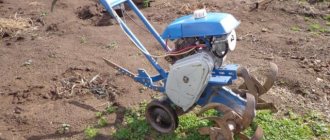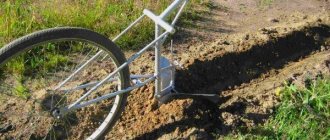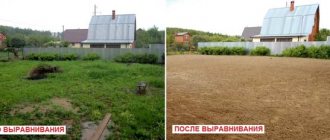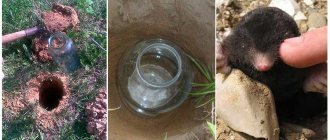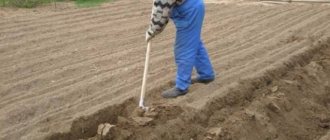The Mole motor cultivator is the first domestically produced small-sized device for cultivating land. The first model was assembled in 1983 at Moscow. It was a low-power milling-type cultivator with a limited set of functions without the ability to install attachments. The engine power reached 2.6 liters. With. with a volume of 60 cm3. The designers used the same carburetor as on the Riga mopeds, and the MB-1 electronic ignition was borrowed from the Druzhba chainsaw.
When designing the next series of motor cultivators Krot 2, the designers took into account the shortcomings of the first model. The new modification received a 4-stroke engine, a reinforced chain gearbox and reverse gear.
Modern samples meet all the requirements for compact land cultivation devices. Cultivators are assembled at machine-building plants in Moscow and Omsk.
Modifications of Mole cultivators
Let's look at the features of the most popular modifications that have appeared since the first Mole cultivator was released.
Technical characteristics of the MK series
The group is represented by middle-class models with a capacity from 2.6 to 5.5 liters. With. and weighing from 48 to 53 kg. The width of plowing land does not exceed 600 mm. The maximum tillage depth is 250 mm.
Motor cultivators of this series are designed to perform work on small summer cottages with an area of no more than 20 acres. It is possible to install attachments to expand functionality.
DDE V700II Series Specifications
A characteristic feature of the series cultivators is a powerful 6.5 liter gasoline internal combustion engine. With. AI 92 gasoline is used as fuel. The DDE 2 model is equipped with a reverse gear, which increases maneuverability and simplifies control of the cultivator.
Reliable chain gearboxes and easy starting in any weather, thanks to a manual starter, make the representatives of the series ideal assistants on large summer cottages and farms.
Technical characteristics of the cultivator Mole M
A mid-class model equipped with a reliable forced air-cooled engine from Honda with a power of 5 hp. With. The motor resource declared by the manufacturer is 1500 hours. The working width is 350 mm, and the depth is adjustable using the built-in coulter from 150 to 250 mm. Reverse gear improves maneuverability and simplifies handling of difficult areas.
The device is easy to operate and easy to maintain. Recommended fuel type is gasoline not lower than AI 92.
Models and their characteristics
A large number of models indicates that the manufacturer is continuously improving existing modifications, following modern trends and trying to launch production of cars of different classes. Thanks to cooperation with foreign manufacturers, new engines began to be installed on Krot cultivators, which have proven themselves well on foreign-made models. Let's get acquainted with the design features of Mole motor cultivators.
MK-1A
The device is a modification of the very first model. There are several options for execution. The most widely used motor cultivators are Krot MK-1A-02.
Specifications:
- Power – 2.6 l. With.;
- Clutch type – belt;
- Plowing width – adjustable within 350-600 mm;
- Processing depth – 250 mm;
- Weight – 48 kg.
The air-cooled power unit is simple and reliable. The fuel used is a mixture of AI-80 gasoline and M-12 TP oil in a ratio of 40:1. The use of a centrifugal regulator contributes to economical consumption of the fuel mixture. Torque from the engine is transmitted using a chain gearbox.
The manufacturer recommends using the cultivator for milling, loosening, harrowing, weeding between rows and leveling the soil in summer cottages and garden plots up to 10 acres. Suitable for processing difficult soils and virgin areas. Installation of additional equipment is possible.
MK 3A-3
The next stage in the development of the basic models of the 1A series.
The main characteristics of the motor cultivator include:
- Power – 3.5 l. With.;
- Clutch type – belt;
- Plowing width – adjustable within 350-600 mm;
- Processing depth – 250 mm;
- Weight – 51 kg.
The main difference between the MK 3A-3 and earlier models is the presence of reverse gear. Thanks to reverse, the performance of the device has increased due to improved controllability.
The engine for the Mole MK 3A-3 motor-cultivator is a Chinese-made GeoTeck gasoline engine.
The manufacturer recommends operating the motor-cultivator at temperatures from +1 to +40ºС. In winter, operation of the model is difficult due to the difficulty of starting and unstable operation of the motor.
The overall dimensions allow the cultivator to be easily transported in the trunk of a medium-sized sedan car.
MK-4-03
Productive model with increased processing area.
The main characteristics of the motor cultivator include:
- Power – 4.0 l. With.;
- Clutch type – belt;
- Plowing width – adjustable within 350-900 mm;
- Processing depth – 250 mm;
- Weight – 53 kg.
The designers used a reliable American Briggs & Stratton engine as the drive mechanism. A high-quality cast-iron liner, a vertical crankshaft arrangement, a lateral arrangement of valves and a well-thought-out air filtration system made it possible to achieve a good service life - up to 3000 operating hours, subject to the break-in rules and the requirements of the operating instructions. Recommended fuel is unleaded motor gasoline. The use of low-quality petroleum products will lead to the formation of carbon deposits in the combustion chamber.
The motor cultivator is suitable for cultivating soils of any complexity. Reverse gear facilitates the process of working in cramped conditions. To expand the capabilities of the device or increase productivity, you can install auxiliary equipment.
MK 5-01
Mole cultivators MK 5-01 have similar characteristics to the MK-4-03 model. The only difference is the engine brand. The MK 5-01 cultivators are equipped with Japanese four-stroke Honda GC135 engines with a horizontal crankshaft.
This engine has proven itself well as a drive mechanism for various garden equipment, including lawn mowers and motor pumps. Thanks to a high-quality carburetor and a well-thought-out power system, the unit is one of the most economical engines in its class. Its consumption is 230 g/l. b*tch Operates on unleaded gasoline with an octane rating of at least 92. Engine oil change intervals (SAE 10-30) are 25 hours.
The engine life declared by the manufacturer is 5000 hours. As practice shows, if the requirements of the operating manual are observed, as well as the use of high-quality gasoline, the service life of the engine increases by 1.5 times.
MK-9-01/02
Powerful cultivator with the following characteristics:
- Power – 5.5 l. With.;
- Clutch type – belt;
- Plowing width – adjustable within 350-600 mm;
- Processing depth – 250 mm;
- Weight – 53 kg.
The power unit of the Mole MK-9-01/02 motor-cultivator is a Hammermann four-stroke gasoline engine, which is characterized by good maintainability. The forced air cooling system ensures effective heat removal, which extends the service life of the device. The duration of running-in of rubbing parts is 5 hours. According to the owner's manual, the oil must be changed every 50 hours.
The motor cultivator is suitable for cultivating large areas with all types of soil. The ergonomic design of the handles and the convenient position of the control levers contribute to comfortable work with minimal effort on the part of the operator. The model is adapted for installation of auxiliary attachments.
Description
The standard cultivator Mole of the most common model MK-1A consists of the following elements:
- The frame is a supporting structure that takes on the weight of the engine with gearbox;
- The gasoline engine is a single-cylinder power unit that, through a gearbox, ensures rotation of active working parts (mills, weeders) and movement of the cultivator when using a hiller and other passive tillage implements;
- Fuel tank - a container located above the engine and designed to store the fuel mixture;
- A gearbox is a mechanism connected to the engine crankshaft and converts the translational movement of its piston into rotation of a shaft with cutters and lugs.
- Rear support (transport) wheels - designed for transporting the unit from the garage or car to the place of work, milling and loosening the soil using active working bodies (front soil mills);
- Coulter - a ripper located on the frame between the support wheels, with the help of which the depth of soil cultivation is set by the working parts installed in the front part (mills, weeders);
- Steering column - double-horned handle with rubberized handles and clutch control levers, carburetor throttle, gear selector (forward/reverse gears);
- Protective shields are installed in front above the cutters and serve to protect the worker from dirt, stones, and debris flying out from under the working parts.
In the early eighties of the last century, owners of summer cottages and vegetable gardens were offered specialized equipment for the mechanization of agricultural work - a lightweight motor cultivator Mole MK-1 2.6 hp. The design of the unit was the simplest - a gearbox and engine on a frame, secured with bolts, a steering wheel, a bracket and a starter made of a simple rope.
A natural continuation was the continuous modernization of the unit, expansion of functions, equipping with powerful engines and durable gearboxes. Today, the Krot family of walk-behind tractors and walk-behind cultivators includes many different models, which are produced at the machine-building enterprise named after. V.V. Chernyshev (Moscow) and on (Omsk) with the trademark “Krot-Om”.
We invite you to familiarize yourself with the spicy culture of ginger: how to grow it at home, planting and care
Fuel consumption by Mole cultivators
Mole cultivators with two-stroke engines operate on a fuel mixture, which consists of AI 76 or 80 gasoline and M12-TP or MG-8A oil. The exact mixing proportions are indicated in the user manual. The mixture is best prepared in a dry canister for storing petroleum products. First, gasoline is poured into the container. Otherwise, the oil will stick to the bottom of the canister, which will complicate the process of preparing a quality mixture. Average fuel consumption – 1300 g/hp*h.
Models with four-stroke engines cause fewer problems for owners. The fuel is AI-92 motor unleaded gasoline, which does not need to be mixed with oil. At the same time, the average fuel consumption of such devices is noticeably lower - 530 g/hp*h.
"
Note! For work at an altitude of more than 1500 meters above sea level, the use of low-octane gasoline is allowed. At the same time, the jets on the carburetor are changed to correct the composition of the air-fuel mixture.”
How to work as a Mole
Working with a motor cultivator consists of the following operations:
- Attaching the steering column to the frame - this operation is performed if the unit was transported in the trunk of a car;
- Preparation of an oil-gasoline mixture in a ratio of 1:40 (MG-8A brand oil) or 1:20 (M-12P brand oil, AZMOL Start2T);
Important! When running in the engine of a recently purchased cultivator, during its running-in (run-in) during the first 14-15 hours, the ratio of the above oil-fuel mixture is 1:25 (MG-8A) and 1:16 (M-12P, AZMOL Start2T). To prepare this mixture, other brands of oils not specified in the instructions for use of the unit cannot be used.
- Moving the walk-behind tractor on the rear support wheels to the work site with the engine not running;
- Installation of working parts;
- Adjustment of processing depth;
- Opening the supply valve on the fuel line running from the gas tank to the carburetor;
- Pressing the choke on the carburetor 2-3 times;
- Setting the throttle control lever to 30-400 relative to the initial closed position;
- Starting the engine - by sharply pulling the starter cable and holding the clutch lever depressed, the engine starts. After starting, the lever controlling the throttle valve sets the required level of engine speed.
Important! It is strictly forbidden to start the walk-behind tractor with the clutch not depressed - this can lead to injuries and more tragic consequences, both for the unit itself and for the person working with it.
We suggest you read How to make useful things from an old washing machine
Operation of Mole motor cultivators instructions
The user manual contains general characteristics of the model, design features, maintenance intervals, recommendations for the safe operation of the cultivator and other important information. The quality of work performed and the service life of the device depend on compliance with the instructions.
The use of attachments is intended to expand the range of work performed. Let's consider all the possibilities.
Plowing
This is done using a special plow. Before performing work, you can adjust the basic parameters - plowing depth and blade angle, choosing the optimal position depending on the type of soil.
There should be no stones or large branches on the land to be cultivated. The speed and direction of movement are chosen based on the geometric shape and characteristics of the site. For example, it is more convenient to cultivate a rectangular vegetable garden moving in a circle, and a square one – moving in zigzags. If there are a lot of small stones in the ground, it is better to perform work at low speed to avoid injury.
Hilling
Sprinkling the lower part of the plant with loose soil is done using a hiller, which is installed in place of the opener. The purpose of the procedure is to protect the stem, stimulate growth, control weeds, as well as drainage and aeration.
Weeding
Removal of weeds that interfere with the normal growth of beneficial crops. This procedure is recommended to be combined with hilling.
Planting and digging potatoes
Mechanization of planting and digging potatoes saves effort and time. To carry out the work, you must first mark the area. Then they begin cutting furrows and then planting potatoes. The furrows are filled using a hiller.
It is better to harvest in warm and dry weather. In this case, soil will not stick to the tubers.
Mowing grass and making hay
To work with grass, you will need to install a rotary mower. With its help, you can quickly tidy up the lawn, clear the area of weeds and prepare hay for animals. To work on flat areas, you can use a segment mower. Mowing grass on surfaces with complex terrain is carried out using rotary attachments.
Transportation of goods
The use of trolleys allows you to transport various loads, the weight of which depends on the type of structure. It is also necessary to take into account the power of the cultivator - excessive loads negatively affect the service life of the engine and gearbox.
Pumping water
To perform such work you will need a pump. When choosing such devices, pay attention to the main characteristics: performance, maximum lift height and suction depth.
Cleaning the area
This is done using various devices. To clear the area of snow, they use blades that look like bulldozer blades. In summer and spring, sweeping brushes can be installed. They will effectively clean any hard surface.
How to work as a Mole
Each of the types of work performed by a motor-cultivator has its own technical features in the preparation and attachment of the corresponding mounted implements, and the technology of execution:
- Milling, loosening, weeding - with this type of work, the cutter is installed on the gearbox shaft, and the loosening depth is set using the coulter. After starting the engine, the unit goes deep and begins to move forward along the treated area with smooth pushes.
- Planting potatoes, hilling - the cutter is removed from the gearbox shaft, and metal wheels with lugs are installed. The rear support wheels are removed and a single-body hiller is installed on the cultivator. When planting, cut a furrow, manually place a potato seed in it, and then use the same hiller to fill up the row planted in this way. When hilling, instead of wheels with lugs, protective wheels are installed on the gearbox shaft. The formation of the ridge occurs when the hiller moves between two rows of crops.
- Harvesting potatoes - remove the cutter and support wheels from the motor cultivator, install metal wheels with lugs and a fan potato digger. They dig up potatoes, using such attachments, directing them exactly in the center of the row. At the same time, the body of the potato digger lifts the tubers, which, falling on the fan of twigs, are freed from the ground and, falling from them, remain lying on the soil.
- Mowing grass - for mowing, the front cutter is removed and rubber-coated iron wheels are installed in its place. The segmented walk-behind mower is connected to the front of the cultivator frame; it is driven by a belt installed on the pulleys of the unit and the cultivator engine.
- Water pumping - the pumping station is installed in front of the cultivator. The pump, like the mower, is driven using a V-belt drive. To pump out water, an intake hose with a filter and a discharge hose are put on the corresponding pipes of the pumping station (lowered into a container).
- Transportation of goods - rubber-coated metal or pneumatic wheels are installed on the gearbox shaft, the support wheels and the coulter are removed, in place of the latter a coupling device is installed, to which the cart with the body is attached using a finger. The trolley transports bulk and other cargo weighing no more than 200 kg.
Important! When digging potatoes with a conveyor potato digger and mowing tall grass, in order to increase the traction force and productivity of the unit, a factory or homemade creeper is installed on it.
Attachments for motor cultivators
- plowing land (with 2–3 sets of cutters);
- inter-row weeding (special tools in the shape of the letter “L”, disks for protecting cultivated plants will be required);
- hilling, digging up potatoes (wheels with hooks for soil are attached, a hiller or digger is installed, depending on the type of work);
- grass cutting (mounted mower, wheels);
- pumping water from a reservoir (pump MNU-2);
- transportation of goods up to 200 kg (rubber wheels, TM-200 trailer).
Selecting attachments
Before purchasing attachments for the Mole cultivator, you must acquire a special coupling device. It can be used to install additional accessories. Depending on the type of design, the coupling device can be non-adjustable or movable. In the first case, the hitch is rigidly fixed without the possibility of adjusting the location, and in the second, the installation angle can be changed, depending on the nature of the work.
Let's look at the most common types of attachments, as well as their design features. Please note that if you have certain skills, you can make auxiliary equipment for a mole cultivator with your own hands.
Plow
To install the plow, the cutters and coulter are removed from the cultivator. Grousers are put on the gearbox shaft, and a reversible plow is installed in the rear using a coupling device. It is used to plow the soil.
When choosing a plow for the Mole motor-cultivator, you need to pay attention to the build quality and strength of the materials. The structure must be collapsible. This will simplify the maintenance and repair of the device - the broken element is simply removed and replaced with a new one.
Trailer
To install the cart, the rotor attachments and coulter are removed from the cultivator. The drive wheels are installed in the front part of the device, and the trailer is installed and secured using a pivot assembly.
Using a trailer you can transport fertilizers, humus, soil, hay and even construction materials.
High-quality trolley models are equipped with seats and closed compartments for storing tools. We advise you to pay attention to the quality of the body. Products assembled from galvanized steel will last much longer than similar devices without protection, due to their high resistance to adverse external factors.
Wheels
Unfortunately, only small transport wheels are commercially available. To install full-fledged pneumatic tires on disks, you must independently upgrade the cultivator, which requires additional financial costs and time. It’s easier to buy lug devices.
Spare parts and additional equipment
Attachments for walk-behind tractors Krot, Sadko, Don, Huter, Profi, Plowman, Champion are diverse. You can turn your assistant into a wheelbarrow tractor, use it for cultivating potatoes, as a lawn mower and as a water pump for watering your garden or garden. The number of parts is small.
Plow
If there is a need and desire, you can unhook the cutters from the unit and install wheels in their place. And attach a plow for the “Mole” walk-behind tractor to the device. It is installed in place of the opener. When cultivating soil, it works best in conjunction with cutters.
Milling cutters
Knives, as they are commonly called, cutters, are installed on the gearbox shaft . The cutters for the Mole walk-behind tractor rotate, while removing the top layer of soil, mixing and crushing it. Plus, thanks to these rotational movements, the device moves forward.
The standard configuration includes four cutters, but their number can be increased to six. How deeply the soil is loosened depends on the position of the attached coulter.
Oil seals
There are five oil seals for the Mole walk-behind tractor . Their task is to maintain sealing in connections. Their place is the crankshaft journal. The unit is equipped with a two-stroke motor, which is considered especially vulnerable if the seal is broken.
If the seals have become unusable, the engine will have difficulty starting, and the speed will be unstable when idling. These parts can only be replaced - their repair is not possible.
Pulley
The pulley for the motoblock Mole, Carver, Husqvarna, Lifan 6.5, Salyut, Niva can be made of materials such as cast iron, steel, aluminum. Parts made of light alloys are considered the most attractive for installation If you are thinking of changing the engine on your “Mole”, then take care of purchasing pulleys.
You will need parts with an internal diameter of 20 mm, 19.05 mm, or 18 mm - depending on which motor you like.
The pulleys are located in the same plane with a deviation of no more than 1 mm.
Pulley
Piston ring
The piston ring of the Mole walk-behind tractor is replaced if the gap at the joint of the rings is more than 1 mm . They are inserted one by one into the cylinder to a depth of eight to ten millimeters.
There is a whole so-called cylinder-piston group for the Mole walk-behind tractor unit. There are two piston rings in it. The material from which the rings and other parts of the group are made, as well as the accuracy of their fit, greatly influences the working life.
Here are the elements of this group:
- Piston pin 11mm;
- Piston rings 2 pcs. ;
- Cylinder;
- Piston.
To prevent the parts of the cylinder-piston group, and all the others, from drying out, do not let the walk-behind tractor stand idle for more than one season. This has a detrimental effect on the device, which, if used regularly, practically does not kill.
The magneto on the “Mole” walk-behind tractor, namely its coil, becomes inoperative when the equipment is left idle for a long time.
Wheels
Wheels for the Mole walk-behind tractor can be completely different, depending on the work that is planned to be carried out. Sometimes they simply rise or are removed altogether. This is what they do when weeding. One way or another, wheels for all occasions are not provided for the walk-behind tractor.
Wheels differ from each other in the material from which they are made, width, diameter, and seat size. For example, when working among rows of crops, narrow tires are needed, while when digging up potatoes, wide tires are needed. And when the gearbox is located above the plants during operation, the diameter of the wheels must be large so as not to damage the crop.
Cultivation is the loosening of soil that has previously been processed, cutting off weeds and other plants harmful to the crop. A do-it-yourself manual cultivator will save you a lot of money.
A very pressing issue is the treatment of trees and other greenery with special chemicals, which will provide protection against parasites. Here is all about the advantages of the Marolex sprayer.
ZIL-130 is a common Soviet-era truck. By clicking on the link you can familiarize yourself with its technical characteristics.
Since the mass of the walk-behind tractor is small, rubber wheels will not always be able to pull it out and turn and slide. In this situation, metal wheels with special lugs are put on.
Air filter
An important element thanks to which the normal power of the unit is maintained and less fuel is consumed. The air filter for the Mole walk-behind tractor cleans the air masses from all kinds of particles and dust, which are sufficient when working in the field.
The material from which it is made is paper, which is based on cellulose fiber. If the filter is dirty, the air-fuel mixture will not function properly in the carburetor, which will negatively affect the operation of the device. Contamination is assessed visually.
If the filter is still dirty, it must be replaced immediately. Alternatively, it can be disassembled and cleaned, but this is only in case of surface contamination.
Disassembling the filter proceeds as follows:
- The filter housing is removed by unscrewing the nut on it.
- The body is washed with water and wiped dry.
- The filter element can be cleaned with a jet of air.
- If this does not help, the filter is replaced.
Never operate the walk-behind tractor without a filter element.
Tracked module
Installing a tracked module will allow the cultivator to navigate off-road, loose snow and other difficult surfaces. The device provides good cross-country ability on all types of surfaces, increases stability and eliminates the possibility of equipment slipping.
Track tracks are usually made of polymer materials. This approach makes it possible to reduce the weight of the structure, which will reduce the load on the drive mechanism.
Nowadays it is quite difficult to find a tracked module adapted for installation on the KROT cultivator. We recommend looking for universal mechanisms that are produced for MB type walk-behind tractors. Some models are compatible with the products of JSC MMP im. V.V. Chernyshev".
Lugs
They are made of high-quality metal with a special coating that protects the structure from corrosion and external influences. Grousers are used to improve traction with the supporting surface and increase the weight of the cultivator, which simplifies movement on loose soil.
The main parameters of lugs are diameter and width. Due to the simplicity of the design, many cultivator owners prefer to make this type of attachment themselves.
snow blower
Snow blowers are designed to clear snow from paths, sidewalks, garden plots, parking areas and other places where the use of large equipment is difficult or impractical.
The principle of operation of the mechanism is based on the rotation of the shaft, which captures the snow mass and moves it to the center with subsequent release through a special bell. The range depends on the engine speed.
Potato planter
Simplifies the process of planting root crops. The simplest models are designed for planting potatoes in one row with a given step. Productivity depends on the type of model and the capacity of the planting material hopper.
High-quality models perform a full working cycle in one pass - the device cuts a furrow, pours potatoes into the holes, covers them with soil and forms even rows. In this case, the depth of processing, planting frequency, row spacing, as well as the height and shape of the ridge can be set in advance.
Potato digger
Helps in harvesting. The simplest fan design is a ploughshare with welded curved metal rods. The use of such devices allows for the presence of weeds during the work process.
The operating principle of the potato digger is as follows:
- The ploughshare loosens the ground with its sharp edge;
- The root crop is removed from the ground and falls on the inclined part of the ploughshare, moving towards the rods;
- The soil separates from the potatoes and falls to the ground through the rods;
- Clean root crops fall onto the arable land.
Many plot owners make their own equipment for harvesting potatoes.
Weights
The purpose of this attachment is to increase the total weight of the cultivator. This makes it easier to navigate difficult surfaces due to better traction.
A classic weighting agent is a cylindrical metal container that is filled with bulk materials.
Possible malfunctions and repairs
Despite the fact that the design of Krot cultivators is simple, violations of the operating instructions, failure to comply with maintenance regulations, as well as the use of low-quality fuel can lead to breakdowns of the device.
Let's look at the main causes of malfunctions, as well as ways to eliminate them.
Engine
The first models of Mole cultivators had many complaints from owners regarding the poor build quality of the engines. The main problems were low resource and frequent failures. Another common malfunction that every second owner has encountered is deformation of the exhaust valve with subsequent wear of the piston.
Manufacturers found a way out of the situation - they began installing proven imported engines on new models, which had proven themselves well abroad.
Ignition
The main ignition problems include:
| Possible faults | Remedies |
| No spark | Make sure the spark plug is working properly. Cleaning and purging of electrodes. Setting the gap. If necessary, replace with a new one. |
| Problems with suppressive resistance | Check serviceability. If necessary, replace with a new one. |
| Unreliable high-voltage wire connection | Restore normal connection. |
| Violation of the integrity of the wire insulation, short circuit of current-carrying elements or the “START” button to the housing | Restoring insulation. Finding and eliminating short circuits. |
| The magneto cores touch the flywheel plates | Insulate the magnetic circuits of the magneto. |
| Magneto has failed | Replace magneto |
| Air filter clogged | Checking and purging the filter. Replace if necessary. |
| Cracks in fuel pipes | Restoring the tightness of tubes. Replace if necessary. |
Replacing the magneto in the Mole cultivator
The magneto in Mole cultivators cannot be repaired. If it fails, you just need to install a new device. As was written above, domestic devices have good maintainability. The magneto replacement procedure confirms this.
Scheme of work execution:
- Remove the starter, holding the impeller;
- We remove the magnets using a special device;
- We take out the faulty magneto and install a new one;
- We solder the button and carry out assembly and performance testing.
Carburetor
The ease of starting the engine and the stability of its operation depend on the condition of the carburetor. The penetration of dust and small debris leads to blockages that will prevent the rated power from being achieved.
The carburetor is responsible for forming the air-fuel mixture. The unit requires periodic adjustment, in accordance with the manufacturer's instructions. This procedure is carried out at least once a season, as a rule, before starting work. Carburetor adjustment is carried out in idle mode.
At the beginning of the season, it is recommended to check the carburetor for condensation that may have accumulated during inactivity. The unit is washed with a special liquid. Carburetor cleaner can be purchased at any automotive store.
Gearbox
The gearbox transmits torque from the engine to the working parts. Checking this unit comes down to monitoring the lubricant level. Working without oil will lead to rapid wear of all gearbox parts. The frequency of inspection is daily, before performing work.
Reverse
The cultivator reverse usually does not work when the adjustment settings are reset. To restore the functionality of the mechanism, perform the following operations before starting the engine:
- Screw in the adjusting screw until it stops;
- Insert the bracket into the first two holes from the lever mounting axis;
- Start the engine and engage reverse.
If reverse does not work, turn out the adjusting screw until reverse gear is engaged. These operations must be repeated several times.
The adjusted reverse gear is activated with a characteristic click, without any extraneous sounds. There are no cases of spontaneous gear shifting.
Another probable reason for the lack of reverse is a mismatch of gear teeth and gear cavities. In this case, it is necessary to move the lever to the “STOP” position and crank the engine manually using the starter.
Belt
The V-belt is responsible for the operation of the clutch. To protect against mechanical damage there is a special casing.
Correct adjustment affects the reliability and life of the belt. The recommended deflection value is 26 mm. During operation, the tension is adjusted using a screw located on the handle.
Preparing the cultivator for storage
The rules for storing a cultivator differ depending on the duration of inactivity. For short-term storage, up to 3 months, the engine is started until the fuel in the carburetor is completely exhausted. Then daily maintenance is carried out followed by lubrication of the moving elements.
For long-term storage, up to one year, in addition to the above work, pour 70 grams of oil into the cylinder and manually turn the crankshaft several revolutions. The surface of the cultivator is wiped with a rag soaked in gasoline. This will prevent the formation of corrosion spots.
